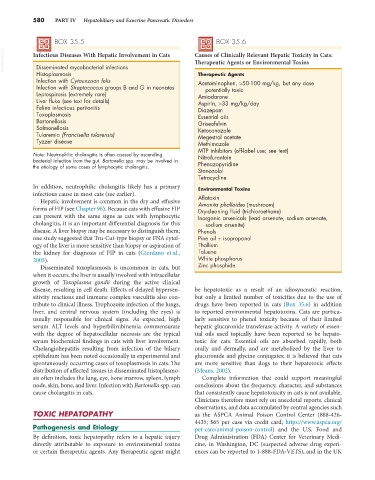Page 608 - Small Animal Internal Medicine, 6th Edition
P. 608
580 PART IV Hepatobiliary and Exocrine Pancreatic Disorders
BOX 35.5 BOX 35.6
VetBooks.ir Infectious Diseases With Hepatic Involvement in Cats Causes of Clinically Relevant Hepatic Toxicity in Cats:
Therapeutic Agents or Environmental Toxins
Disseminated mycobacterial infections
Histoplasmosis Therapeutic Agents
Infection with Cytauxzoon felis Acetaminophen, >50-100 mg/kg, but any dose
Infection with Streptococcus groups B and G in neonates potentially toxic
Leptospirosis (extremely rare) Amiodarone
Liver fluke (see text for details) Aspirin, >33 mg/kg/day
Feline infectious peritonitis Diazepam
Toxoplasmosis Essential oils
Bartonellosis Griseofulvin
Salmonellosis Ketoconazole
Tularemia (Francisella tularensis) Megestrol acetate
Tyzzer disease Methimazole
MTP inhibitors (off-label use; see text)
Note: Neutrophilic cholangitis is often caused by ascending Nitrofurantoin
bacterial infection from the gut. Bartonella spp. may be involved in Phenazopyridine
the etiology of some cases of lymphocytic cholangitis.
Stanozolol
Tetracycline
In addition, neutrophilic cholangitis likely has a primary Environmental Toxins
infectious cause in most cats (see earlier). Aflatoxin
Hepatic involvement is common in the dry and effusive Amanita phalloides (mushroom)
forms of FIP (see Chapter 96). Because cats with effusive FIP Dry-cleaning fluid (trichloroethane)
can present with the same signs as cats with lymphocytic Inorganic arsenicals (lead arsenate, sodium arsenate,
cholangitis, it is an important differential diagnosis for this sodium arsenite)
disease. A liver biopsy may be necessary to distinguish them; Phenols
one study suggested that Tru-Cut-type biopsy or FNA cytol- Pine oil + isopropanol
ogy of the liver is more sensitive than biopsy or aspiration of Thallium
the kidney for diagnosis of FIP in cats (Giordano et al., Toluene
2005). White phosphorus
Disseminated toxoplasmosis is uncommon in cats, but Zinc phosphide
when it occurs, the liver is usually involved with intracellular
growth of Toxoplasma gondii during the active clinical
disease, resulting in cell death. Effects of delayed hypersen- be hepatotoxic as a result of an idiosyncratic reaction,
sitivity reactions and immune complex vasculitis also con- but only a limited number of toxicities due to the use of
tribute to clinical illness. Trophozoite infection of the lungs, drugs have been reported in cats (Box 35.6) in addition
liver, and central nervous system (including the eyes) is to reported environmental hepatotoxins. Cats are particu-
usually responsible for clinical signs. As expected, high larly sensitive to phenol toxicity because of their limited
serum ALT levels and hyperbilirubinemia commensurate hepatic glucuronide transferase activity. A variety of essen-
with the degree of hepatocellular necrosis are the typical tial oils used topically have been reported to be hepato-
serum biochemical findings in cats with liver involvement. toxic for cats. Essential oils are absorbed rapidly, both
Cholangiohepatitis resulting from infection of the biliary orally and dermally, and are metabolized by the liver to
epithelium has been noted occasionally in experimental and glucuronide and glycine conjugates; it is believed that cats
spontaneously occurring cases of toxoplasmosis in cats. The are more sensitive than dogs to their hepatotoxic effects
distribution of affected tissues in disseminated histoplasmo- (Means, 2002).
sis often includes the lung, eye, bone marrow, spleen, lymph Complete information that could support meaningful
node, skin, bone, and liver. Infection with Bartonella spp. can conclusions about the frequency, character, and substances
cause cholangitis in cats. that consistently cause hepatotoxicity in cats is not available.
Clinicians therefore must rely on anecdotal reports, clinical
observations, and data accumulated by central agencies such
TOXIC HEPATOPATHY as the ASPCA Animal Poison Control Center (888-426-
4435; $65 per case via credit card; https://www.aspca.org/
Pathogenesis and Etiology pet-care/animal-poison-control) and the U.S. Food and
By definition, toxic hepatopathy refers to a hepatic injury Drug Administration (FDA) Center for Veterinary Medi-
directly attributable to exposure to environmental toxins cine, in Washington, DC (suspected adverse drug experi-
or certain therapeutic agents. Any therapeutic agent might ences can be reported to 1-888-FDA-VETS), and in the UK

